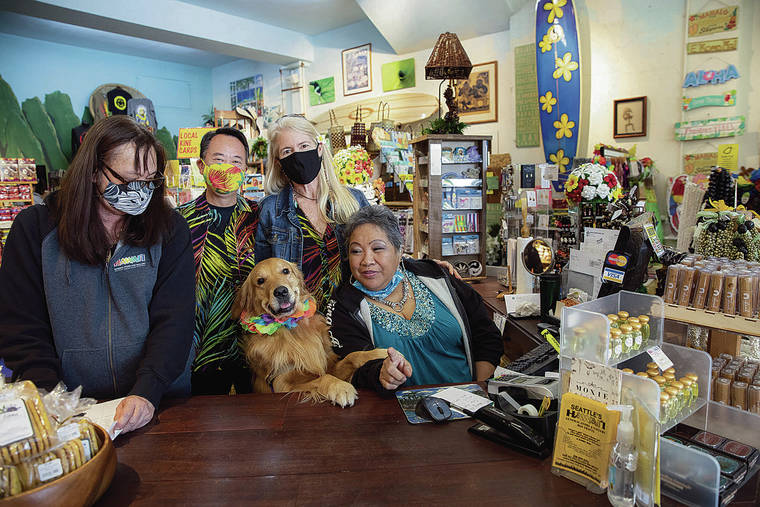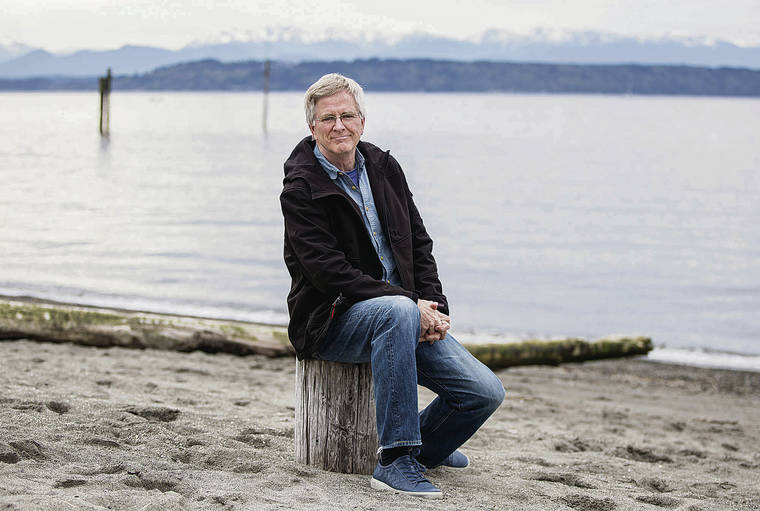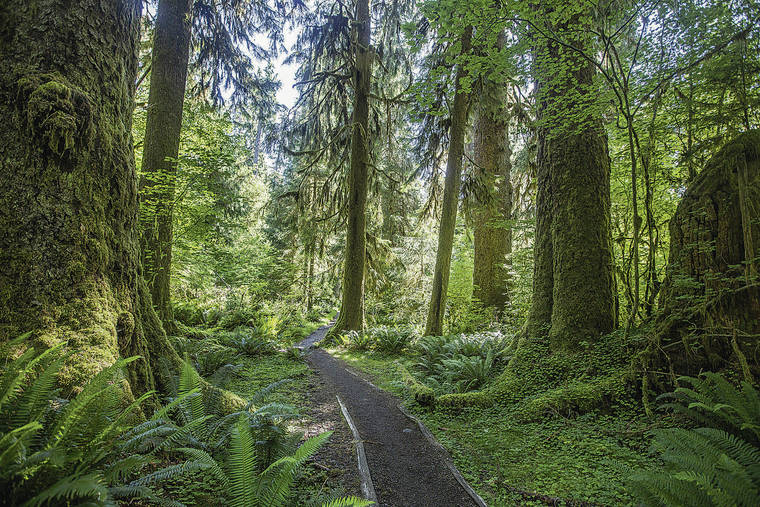Industry experts predict what travel will look like in 2021 and beyond

SEATTLE TIMES
Roxanne See, left, Terry Uemura, Gail Stringer, Dina Manatad and dog Ellie at the Hawaii General Store and HGS Travel in Seattle’s Wallingford neighborho

SEATTLE TIMES
Edmonds, Wash., resident Rick Steves on the beach in downtown Edmonds, is known for his guidebooks and popular European vacation tours. The coronavirus has essentially shut down his touring business.

SEATTLE TIMES
Some Seattle-area travel destinations, such as the Hoh River Trail in Olympic National Park, have been overwhelmed since the coronavirus pandemic effectively shut down international travel.



SEATTLE >> Ask a few people in the travel business how their industry is doing, and you’ll start to hear some common refrains: Travel took a beating in 2020. The market is bursting with pent-up demand. Great deals are everywhere, but the terrain keeps shifting, so consider the help of travel agents. Beaches and parks are in — so, apparently, is littering. Between vaccine distribution hiccups and the new coronavirus variants, nobody knows when the floodgates will truly open.
That last point draws a little more debate. Roger Dow, president and CEO of the U.S. Travel Association (a nonprofit trade group) says his go-to analysts at Tourism Economics predict gradual leisure-travel growth until June, then a spike in July, with corporate travel coming back in the fall.
Mike Estill of the Western Association of Travel Agencies (or WESTA, a profit-sharing cooperative of 150 travel agencies in five states) is more conservative, suspecting 2021 will be the year of booking travel, “but 2022 is going to be when we get healthy.”
Either way, the industry has been depleted and people are eager to get back to business. Dow and U.S. Travel reckon the nation has lost $510 billion in travel spending, and that travel accounted for 11% of prepandemic jobs in the U.S., but has suffered 35% of all pandemic-related job losses.
How have businesses survived this turbulence? How are they planning and positioning themselves for the year ahead? Have these tides fundamentally shifted anything in the industry? That all depends on who’s talking. So here are four postcards from travel industry people in slightly different positions: Europe travel legend Rick Steves, Hawaii travel specialist Gail Stringer, outdoor tour guide Tommy Farris and industry observer Estill.
Mike Estill
Don't miss out on what's happening!
Stay in touch with breaking news, as it happens, conveniently in your email inbox. It's FREE!
Western Association of Travel Agencies
Last year brought trouble to almost every industry — but the travel business had some peculiar hurdles.
“The first four months were catastrophic,” said Estill, chief operating officer of WESTA, a cooperative that works for, among other things, increased purchasing power in the industry.
“If you’re a bar or restaurant, your revenue stream dried up because things got quiet and you had to lay off half your staff,” he explained. “For us, things got super busy because we’ve got cancellations, we’re managing bookings and we’re giving back money for stuff that was already sold — so we’ve got negative cash flow.”
In that environment, he said, people got creative — particularly the cruise industry.
Major cruise lines (Princess Cruise Lines, Holland America, Viking Cruises) offered refunds for canceled voyages but told people if they left their money with the company, they’d get a voucher for 125% of whatever they’d paid. AmaWaterways, which specializes in river cruises in Europe and Asia, quickly started offering two-for-one deals to medical workers and first responders — the first people in line for coronavirus vaccines, and perhaps some of the irst to consider traveling. In December, cruise lines announced no-interest or low-interest bridge loans for struggling travel agents.
“Most of us in the leisure side of the travel business still see ourselves as an ecosystem,” Estill said. “The industry is coming together, supporting itself.” Keeping travel agents around to sell cruises is part of the strategy, Estill said, and so is the public relations gambit: “They realize the value of somebody telling their story.”
Despite the rough conditions, Estill said he didn’t see many WESTA members going under. “The situation has been a catalyst for some agency owners selling their business or retiring,” he said. “But I haven’t seen people who were doing well suddenly collapse.”
Whatever happens, Estill expects the travel industry to rebound.
“Everybody loves to travel,” he said. “My guess is it’s going to come back big. And maybe come back better. I think you’ll see better cleanliness and cognizance of these issues in all areas of the travel industry.”
Rick Steves
“Rick Steves’ Europe”
Last year, when the pandemic first arrived, Rick Steves — travel guide, author, activist, radio and TV host, all-around European travel authority — took a long view, planning to dig in for two years without income.
He canceled all his 2020 tours and would like to lead some in 2021, but is fully prepared to wait until 2022. And he offers zero predictions.
“Nobody knows when it’s going to break loose,” he said. “You can get the best experts in the world together on a panel and nobody will know anything about the future.”
Steves said that, after 30 years of profitable touring, he can afford to keep his Seattle-based staff of 100 employed — preparing new books, editing a year’s worth of raw TV footage — at slightly reduced hours while retaining health insurance. Meanwhile, he’s working to connect his Rick Steves-affiliated guides in Europe with U.S. customers for cooking classes, language classes and other online gigs, but allows it’s “very difficult” for tour guides these days. (Though, he noted, Europeans are tending to get steadier and more substantial government assistance during the pause than their U.S. counterparts.)
He’s eager to get back to touring, but expects individuals and couples to head out first — they can calibrate their comfort levels and improvise much more quickly than a group of 25 — and will wait until his customers can have the full travel experience.
“Social distancing and Rick Steves travel are opposites,” he said. “I’m not going to sell half a tour, not going to Amsterdam to have people sit in a bubble for dinner — I’m not going to change our tours to accommodate incremental freedom.”
Steves knows he’s in a fortunate position to survive two lean years and, even in a weakened economy, expects that demand will outweigh supply. “My mission is not to profit-maximize,” he said. “If I focus on creatively and energetically and passionately inspiring Americans to stop being so afraid, to celebrate the diversity on this planet, it makes everything go better — that’s the most effective promotion. TV goes better, guidebook sales go better and there’s more interest in our tours.”
Gail Stringer
Hawaii General Store and HGS Travel
Gail Stringer thinks Hawaii has never been more gorgeous: fewer people, less traffic, less air pollution, better views.
“It feels like Hawaii when I was a kid,” she said. “It’s like Mother Nature said: ‘Look, this is how Hawaii is supposed to be. When you ramp up again, don’t ramp up like you were before, because that was a destructive path.’”
Stringer grew up on Oahu, came to the mainland for college and settled in Seattle, where she’s run the Hawaii General Store for 22 years and HGS Travel (an all-around travel agency that specializes in Hawaii) for 18 years. She hopes the entire tourism ecosystem will have learned something from this pandemic interlude.
“This is a buzzword and it’s overused, but I’m hoping people will be more mindful about their travel,” she said. “The vast majority of tour and cruise companies we work with have been developing ecotours and small tours — and that’s accelerated during the pandemic.”
She also mentioned Hawaii’s new Malama program, which invites visitors to trade some ecologically oriented volunteer work (beach cleanup, reef restoration, bird recovery) for a free night at a hotel.
“All the major hotels are in on it,” Stringer said. “It’s what I’ve dreamed Hawaii would do for years — they’re coming out of the pandemic better and smarter.”
Does she have any suggestions for the first waves of travelers?
“I can tell the floodgates are about to go,” she said. “I’d stay away from big cities and go to those faraway places, beautiful and remote places while they’re as spectacularly clean as they’ve ever been. And buy insurance. That’s a no-brainer.”
Tommy Farris
Olympic Hiking Co.
While much of the travel industry was precariously wobbling through the late summer of 2020, Tommy Farris, owner of the 4-year-old Olympic Hiking Co., was doing unexpectedly great business.
Early spring had been terrifying — as Washington state shut down, Farris was issuing thousands of dollars in refunds every day to people who’d already booked hikes and snowshoe tours, as well as Olympic’s trailhead shuttle service for backpackers. “It took a lot of sunset beach walks and prayers with my parents to get through that,” he said.
But by July, when the parks had reopened, people were thoroughly stir-crazy from coronavirus lockdowns and ravenous for the outdoors.
“August was our busiest month yet in terms of numbers of trips,” he said. (In 2019, Olympic ran 250 tours and shuttles; in August 2020, they ran 78.) “We were only doing socially distant shuttles and private tours, but it sheds light on what happened this summer with mass exploration of the outdoors.”
“Mass exploration” is a politic way to put it. Olympic National Park closed in mid-March, like much of the rest of the state, but slowly began to reopen in May. In August, herds of people shoved their way into the woods — some starting wildfires, trampling fragile plants and generally trashing the place — which forced parts of the park to close and inspired headlines about “wreckreation.”
Meanwhile, Farris was trying to show his customers the best of the Olympic Peninsula — but it’s been tough at times, especially for people who want to see the marquee sites. One Sunday in mid-January, his snowshoe tour at Hurricane Ridge ran into a three-hour wait. (Farris offered full refunds.)
On top of the COVID-19 crowds, Farris said, Instagram and geotagging have fundamentally changed the foot traffic: “If you are Googling for ‘hidden gem,’ SEO will spit out the same thing for everybody else to see.”
Paradoxically, Farris explained, tourism-related businesses are still struggling. Big crowds don’t necessarily mean money is going to coffee shops, restaurants and hotels. “The lodging tax dollars that are the lifeblood of our tourism economy are not being collected,” he said.
Farris hopes 2021 will bring solutions to last year’s twin problems: overcrowded “wreckreaction” and underfunded local businesses. He wants people to travel locally like they would to far-flung destinations — eating in restaurants, staying in hotels and, yes, using local guides. And he’s heartened that the overcrowding problem has already sparked collaborations among players like the Washington State Department of Natural Resources, the Washington Trails Association and REI.
“It’s our job to show people that this isn’t Wild Waves, where you can just get a great ‘Gram shot and take off,” he said. “These are wild places. It’s inspiring to stand next to a 300-foot Sitka spruce that could be 1,000 years old — what have these trees seen? It makes our one-year problems seem small.”




